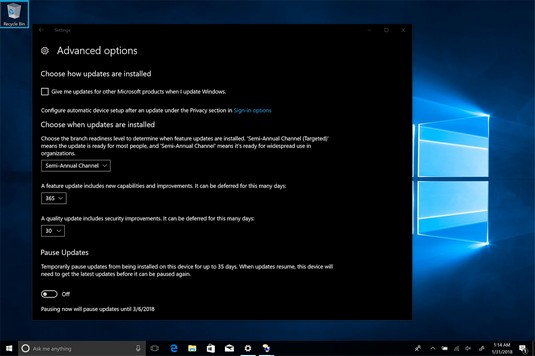 Control Windows Update from here — if you have a newer version of Windows 10 Pro.
Control Windows Update from here — if you have a newer version of Windows 10 Pro.
To take control of patches in Windows 10 Pro (or Enterprise or Education), version 1703 or later, do the following:
- Click or tap Start→Settings (the gear icon), and then click Update & Security. On the right, click the Advanced Options link.The Advanced Options pane appears.
- In the Choose How Updates Are Installed section, select Give Me Updates for Other Microsoft Products When I Update Windows.This step ensures that you’ll get updates for Office at the same time you get updates for Windows.
- In the Choose When Updates Are Installed section, choose Semi-Annual Channel.In earlier versions of Windows, you may see the Current Branch for Business option. If so, choose that.
When a new Windows 10 version is released every six months or so, Windows Update looks at this option to see if you’re willing to upgrade immediately.
If Semi-Annual Channel (Targeted) is selected and updates haven’t been paused, Windows Update looks at the deferral countdown box below (which goes up to 365) and waits the specified number of days before installing the new version.
If Semi-Annual Channel is selected, Windows Update waits until Microsoft sends an all-clear signal, saying that the new version of Windows 10 is ready for business. Typically, that happens three or four months after the new version is released — just enough time for the unpaid beta testers to pound on it. When Microsoft gives the go-ahead and updates haven’t been paused, Windows Update looks at the deferral countdown box and waits the specified number of days before installing the new version.
- In the A Feature Update Includes section, set the drop-down box to 365.
This setting really means that when a new version of Windows 10 is available, Windows Update will wait this number of days before installing it.
If you selected Semi-Annual Channel in the preceding box, Windows Update waits until Microsoft gives the all-clear, and then waits the specified number of days before installing it.
By choosing both Semi-Annual Channel and 365, you’re telling Windows Update to stay away from new versions of Windows 10 for the maximum possible amount of time. In the normal course of events, you’ll wait until you're comfortable with the new version, and then manually flip these to Semi-Annual Channel (Targeted) and 0, thus delivering your machine to Microsoft’s hands, waiting for the new version to hit.
- In the A Quality Update Includes section, set the drop-down box to 30.
In other words, when Microsoft releases a cumulative update for the current version of Windows 10, Windows Update must wait 30 days before installing it.
Because cumulative updates normally hit every Patch Tuesday (the second Tuesday of the month), setting this box to 30 ensure that the update will be installed more or less right before the next cumulative update is available. Ignoring February and leap years, of course.
- Don’t move the slider marked Pause Updates unless you absolutely have no other way to keep Windows Update’s filthy hands off your machine.
Pause updates takes precedence over all the other settings. If you have Pause turned on, Windows stops all updates but Windows Defender https://www.dummies.com/computers/pcs/windows-defender-offers-malware-protection/updates. The problem isn’t in blocking all updates. The problem arises when you exceed the five-day limit or when you turn off Pause Updates.
Microsoft is careful to mention that you can’t reset the Pause Update setting. If you try to turn it off and turn it back on again, “this device will need to get the latest updates before it can be paused again.”
All sorts of things they don’t teach you in Windows 10 school, eh?
Bah. Humbug. The tools are there. Use them to your advantage.





